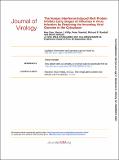Files in this item
The human interferon-induced MxA protein inhibits early stages of influenza A virus infection by retaining the incoming viral genome in the cytoplasm
Item metadata
| dc.contributor.author | Xiao, Han | |
| dc.contributor.author | Killip, Marian Jane | |
| dc.contributor.author | Staeheli, Peter | |
| dc.contributor.author | Randall, Richard Edward | |
| dc.contributor.author | Jackson, David | |
| dc.date.accessioned | 2013-12-09T15:01:01Z | |
| dc.date.available | 2013-12-09T15:01:01Z | |
| dc.date.issued | 2013-12 | |
| dc.identifier | 20574668 | |
| dc.identifier | 7f40be1b-2b43-4392-bb6b-aba0bed8c188 | |
| dc.identifier | 84887131870 | |
| dc.identifier.citation | Xiao , H , Killip , M J , Staeheli , P , Randall , R E & Jackson , D 2013 , ' The human interferon-induced MxA protein inhibits early stages of influenza A virus infection by retaining the incoming viral genome in the cytoplasm ' , Journal of Virology , vol. 87 , no. 23 , pp. 13053-13058 . https://doi.org/10.1128/JVI.02220-13 | en |
| dc.identifier.issn | 0022-538X | |
| dc.identifier.other | ORCID: /0000-0002-9304-6678/work/60427009 | |
| dc.identifier.uri | https://hdl.handle.net/10023/4280 | |
| dc.description.abstract | The induction of an interferon-induced antiviral state is a powerful cellular response against viral infection that limits viral spread. Here we show that a pre-existing antiviral state inhibits replication of influenza A viruses in human A549 cells by preventing transport of the viral genome to the nucleus and the interferon-induced MxA protein is necessary but not sufficient for this process. This represents a previously unreported antiviral function of MxA against influenza A virus infection. | |
| dc.format.extent | 1370580 | |
| dc.language.iso | eng | |
| dc.relation.ispartof | Journal of Virology | en |
| dc.subject | QR355 Virology | en |
| dc.subject.lcc | QR355 | en |
| dc.title | The human interferon-induced MxA protein inhibits early stages of influenza A virus infection by retaining the incoming viral genome in the cytoplasm | en |
| dc.type | Journal article | en |
| dc.contributor.sponsor | The Wellcome Trust | en |
| dc.contributor.institution | University of St Andrews. School of Biology | en |
| dc.contributor.institution | University of St Andrews. Biomedical Sciences Research Complex | en |
| dc.identifier.doi | 10.1128/JVI.02220-13 | |
| dc.description.status | Peer reviewed | en |
| dc.identifier.grantnumber | 087751/A/08/Z | en |
This item appears in the following Collection(s)
Items in the St Andrews Research Repository are protected by copyright, with all rights reserved, unless otherwise indicated.

